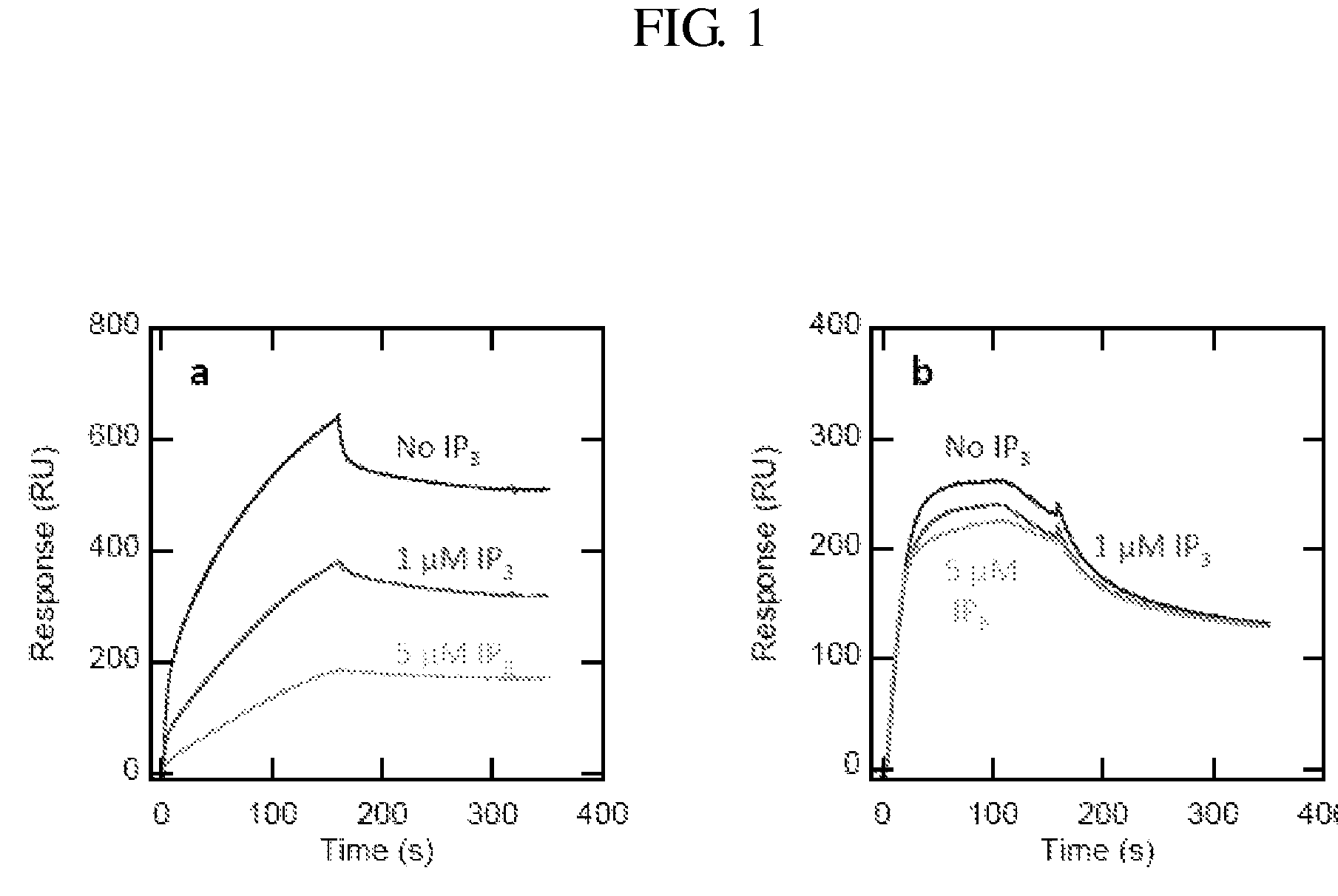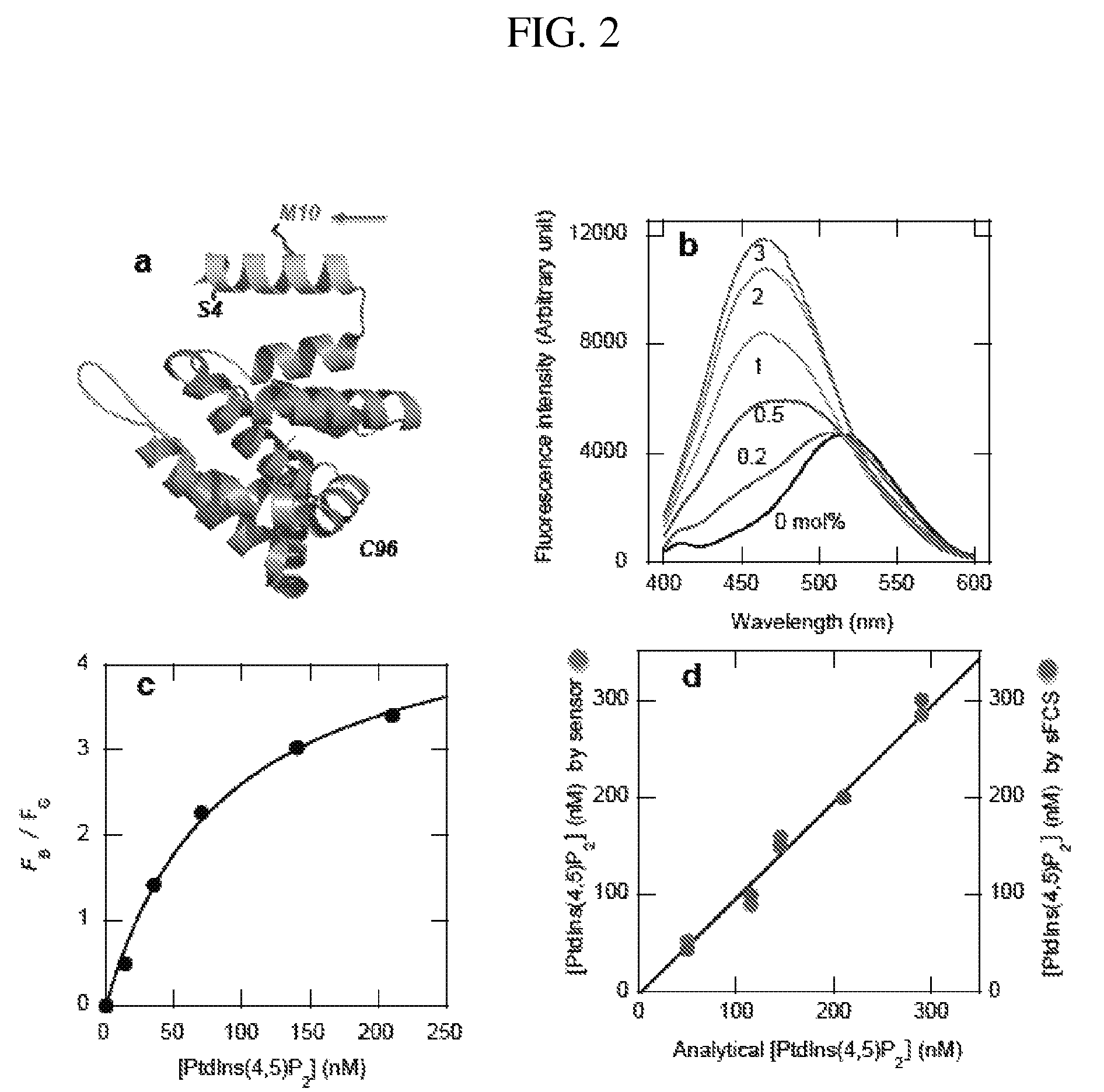Compositions and methods for quantitatively monitoring lipids
a quantitative monitoring and lipid technology, applied in the field of development and use of lipid sensing agents, can solve the problems of low sensitivity and robustness of methods in in situ lipid quantification, methods that do not provide quantitative information, and lipid sensors made of naturally occurring lipid binding domains may not be able to compete with endogenous cellular proteins with higher affinity
- Summary
- Abstract
- Description
- Claims
- Application Information
AI Technical Summary
Benefits of technology
Problems solved by technology
Method used
Image
Examples
example 1
Phosphatidylinositol-4,5-bisphosphate (PtdIns(4,5)P2) Sensor
[0101]A specific sensor for PtdIns(4,5)P2, which has been implicated in numerous cell processes, including membrane remodeling and regulation of membrane proteins and cytoskeletons, was made. Although PtdIns(4,5)P2 is present mainly in the plasma membrane, its actual concentration, distribution, and spatiotemporal fluctuation has not been quantitatively determined. Traditionally, the PH domain of phospholipase Cd tagged with a fluorescent protein has been used as a cellular PtdIns(4,5)P2 probe. However, PtdIns(4,5)P2 imaging by the PH domain is known to be complicated by the ability of inositol-(1,4,5)-triphosphate, which is a hydrolysis product of PtdIns(4,5)P2, to bind the domain and displace it from the membrane. Another PtdIns(4,5)P2-selective protein was selected: the ENTH domain of epsin1 that is more stable and has lower affinity for inositol-(1,4,5)-triphosphate than the PH domain.
[0102]The ENTH domain was engineere...
example 2
Phosphatidyl Serine Sensor
[0112]The Lact-C2 gene was amplified form the EGFP-C1-Lact-C2 vector (purchased from Haematologic Technologies, Inc.) and subsequently subcloned into the pET-21a vector (Novagen). All mutations were generated by PCR mutagenesis and verified by DNA sequencing. To generate a specific turn-on sensor for PS, the DAN group was chemically incorporated to a single free cystein residue introduced to different locations of Lact-C2. Among many engineered Lact-C2 constructs, W26C-DAN showed the best optical property (See FIG. 11(a)) and was thus selected as a specific PS sensor (see FIG. 11(b)). This constructed sensor allows for in situ quantification of PS concentration in the outer (when the sensor is added to the media) and the inner (when the sensor is microinjected) faces of the plasma membrane. We were able to quantify the PS concentration on the outer plasma membrane of apoptotic Jurkat T cells that is necessary for triggering phagocytosis by macrophages. PS c...
example 3
Phosphatidic Acid Sensor
[0113]The Lact-C2 domain was converted into a PA-specific protein through protein engineering based on the crystal structure of Lact-C2 (J. Biol. Chem., (283)7230-7241 (2008)) and our molecular insight into PA and PS binding proteins. In the crystal structure, D80, H83, and Q85 interact with the serine head group of PS, so we mutated them to R, E, and K, respectively, to abrogate PS binding. Since PA has higher negative charge density without the head group, a mutant without PS binding may still interact with PA with high affinity. Our SPR analysis showed that the D80R / H83E / Q85K mutation converted the PS-specific Lact-C2 (FIG. 12(a)) into a PA-selective protein (FIG. 12(b)) and that DAN-Lact-C2-W26C / D80R / H83E / Q85K has desirable spectral properties. See FIG. 12(c). PA formation in NIH 3T3 cells in the presence of the phorbol ester, PMA, was successfully quantified.
PUM
| Property | Measurement | Unit |
|---|---|---|
| diameter | aaaaa | aaaaa |
| diameter | aaaaa | aaaaa |
| diameter | aaaaa | aaaaa |
Abstract
Description
Claims
Application Information
 Login to View More
Login to View More - R&D
- Intellectual Property
- Life Sciences
- Materials
- Tech Scout
- Unparalleled Data Quality
- Higher Quality Content
- 60% Fewer Hallucinations
Browse by: Latest US Patents, China's latest patents, Technical Efficacy Thesaurus, Application Domain, Technology Topic, Popular Technical Reports.
© 2025 PatSnap. All rights reserved.Legal|Privacy policy|Modern Slavery Act Transparency Statement|Sitemap|About US| Contact US: help@patsnap.com



